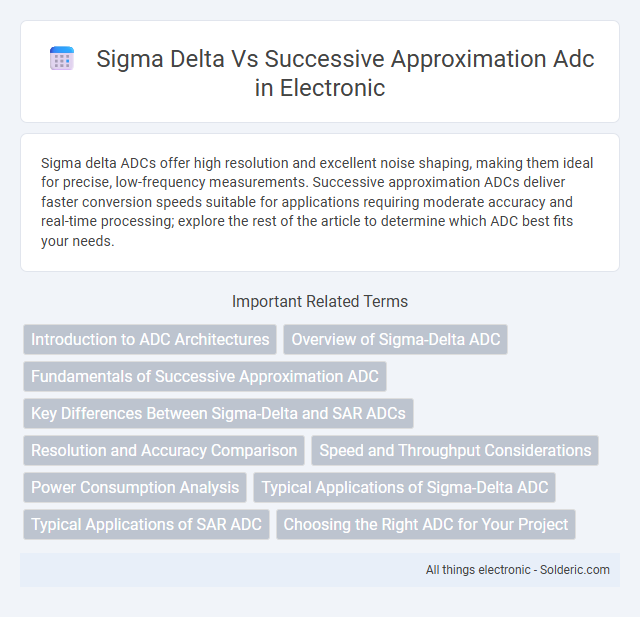Sigma delta ADCs offer high resolution and excellent noise shaping, making them ideal for precise, low-frequency measurements. Successive approximation ADCs deliver faster conversion speeds suitable for applications requiring moderate accuracy and real-time processing; explore the rest of the article to determine which ADC best fits your needs.
Comparison Table
| Feature | Sigma-Delta ADC | Successive Approximation ADC |
|---|---|---|
| Resolution | High (up to 24 bits) | Medium (typically 8-18 bits) |
| Sampling Rate | Low to Medium (up to 1 MHz) | Medium to High (up to several MHz) |
| Conversion Method | Oversampling + Noise shaping | Binary search via DAC comparison |
| Power Consumption | Typically higher due to oversampling circuits | Lower power, efficient for moderate speeds |
| Noise Performance | Excellent noise shaping and filtering | Moderate, depends on design and resolution |
| Latency | Higher latency due to oversampling | Lower latency, faster conversion time |
| Ideal Application | Precision measurement, audio, instrumentation | General-purpose, data acquisition, moderate speed |
Introduction to ADC Architectures
Sigma-delta ADCs utilize oversampling and noise shaping to achieve high resolution and accuracy, making them ideal for audio and precision measurement applications. Successive approximation ADCs operate using a binary search algorithm within a fixed conversion time, offering fast and moderate-resolution conversions suited for real-time systems. Your choice between these architectures depends on the trade-off between speed, resolution, and application requirements.
Overview of Sigma-Delta ADC
Sigma-Delta ADCs convert analog signals to digital by oversampling and noise shaping, achieving high resolution and accuracy ideal for audio and sensor applications. These ADCs use a sigma-delta modulator followed by a digital filter to produce a precise digital output from a low-frequency input. Your choice of a Sigma-Delta ADC ensures superior linearity and dynamic range compared to Successive Approximation ADCs, which rely on binary search algorithms for faster but lower-resolution conversions.
Fundamentals of Successive Approximation ADC
Successive Approximation ADCs convert analog signals into digital form using a binary search algorithm through a sample-and-hold circuit and a digital-to-analog converter (DAC). The core principle involves iteratively narrowing down the input voltage by comparing it with the DAC output until the closest digital equivalent is found. This method offers fast conversion speeds and moderate resolution, making it ideal for medium-speed, medium-resolution applications.
Key Differences Between Sigma-Delta and SAR ADCs
Sigma-Delta ADCs excel in high-resolution, low-frequency applications by oversampling and noise shaping, which reduces quantization noise and improves accuracy. Successive Approximation Register (SAR) ADCs offer faster conversion speeds and lower latency, making them ideal for moderate-resolution, high-speed data acquisition. Your choice depends on the need for precision versus speed, with Sigma-Delta favored in audio or instrumentation and SAR in control systems or communication devices.
Resolution and Accuracy Comparison
Sigma delta ADCs offer higher resolution and superior accuracy due to their oversampling and noise shaping techniques, making them ideal for audio and precision measurement applications. Successive approximation ADCs, while faster, typically provide moderate resolution with accuracy limited by capacitor matching and comparator precision. Your choice depends on whether enhanced resolution or faster conversion speed is the priority in your system.
Speed and Throughput Considerations
Successive Approximation Register (SAR) ADCs offer faster conversion speeds with sampling rates typically up to several megasamples per second, making them ideal for high-speed applications. In contrast, Sigma-Delta ADCs prioritize high resolution and noise shaping at the cost of lower throughput, often operating at lower sampling rates but with oversampling and digital filtering to improve accuracy. Therefore, SAR ADCs excel in speed-critical environments, while Sigma-Delta ADCs are better suited for precision measurement requiring slower data acquisition.
Power Consumption Analysis
Sigma delta ADCs typically exhibit higher power consumption than successive approximation ADCs due to their continuous oversampling and noise-shaping processes. Successive approximation ADCs, designed for moderate resolution and speed, optimize power efficiency by completing conversions within fewer clock cycles. Your choice between these architectures should consider power budgets alongside resolution and speed requirements to achieve optimal system performance.
Typical Applications of Sigma-Delta ADC
Sigma-Delta ADCs are predominantly used in high-resolution applications such as audio signal processing, industrial instrumentation, and precision measurement devices due to their excellent noise shaping and high dynamic range. These converters excel in applications requiring low bandwidth but extremely accurate digital representations of analog signals, including digital audio recorders, seismic sensors, and medical devices like EEG and ECG monitors. Their ability to filter out high-frequency noise and provide superior SNR makes them ideal for environments demanding precise analog-to-digital conversion.
Typical Applications of SAR ADC
Successive Approximation Register (SAR) ADCs are commonly employed in applications requiring moderate resolution and high sampling speed, such as digital voltmeters, data acquisition systems, and industrial control equipment. Their ability to offer fast conversion times and efficient power consumption makes them ideal for battery-powered devices and portable instrumentation. Your choice of SAR ADC ensures precise, real-time signal conversion in embedded systems where latency and energy efficiency are critical.
Choosing the Right ADC for Your Project
When choosing the right ADC for your project, consider that Sigma Delta ADCs excel in high-resolution and low-frequency applications due to their noise-shaping and oversampling capabilities. Successive Approximation Register (SAR) ADCs provide faster conversion speeds and are ideal for medium-resolution applications requiring moderate sampling rates. Your decision should balance resolution, speed, power consumption, and signal bandwidth to meet specific project requirements effectively.
sigma delta vs successive approximation adc Infographic

 solderic.com
solderic.com